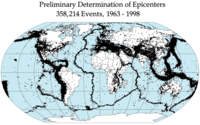
Photo from wikipedia
Abstract Deep dynamic site characterization was conducted at the Central United States Seismic Observatory (CUSSO), which is a 587 m deep vertical seismic array situated in the Mississippi embayment. This characterization… Click to show full abstract
Abstract Deep dynamic site characterization was conducted at the Central United States Seismic Observatory (CUSSO), which is a 587 m deep vertical seismic array situated in the Mississippi embayment. This characterization included a combination of active and passive source surface wave methods and horizontal to vertical spectral ratio (HVSR). These measurements were used in a multimodal joint inversion of Rayleigh and Love dispersion data and the natural site frequency from HVSR (f0) to develop non-invasive VS profiles for the site. Downhole seismic measurements were also made down to 425 m to validate the surface wave method results and understand the uncertainty between the various measurements at the site. The developed VS profiles are compared to published site specific VS profiles from direct measurements, velocity models, and reference VS profile for the embayment to understand the variability and uncertainty between different methods. Major differences in the Vs profiles were noticed in the top 50 m, near the Memphis sand layer, and the Paleozoic bedrock layer. Site signatures from experimental dispersion data, HVSR f0 and empirical transfer function (ETF) were evaluated to assess the appropriateness of the candidate VS profiles. Comparison results indicate the developed VS profiles in this study performed well in capturing the site signatures. However, the theoretical dispersion fits from published VS profiles demonstrated a larger misfit with the experimental data. Theoretical transfer function and Rayleigh ellipticity from published profiles also exhibited considerable differences with the HVSR f0 and ETF amplification factor.
Journal Title: Soil Dynamics and Earthquake Engineering
Year Published: 2021
Link to full text (if available)
Share on Social Media: Sign Up to like & get
recommendations!